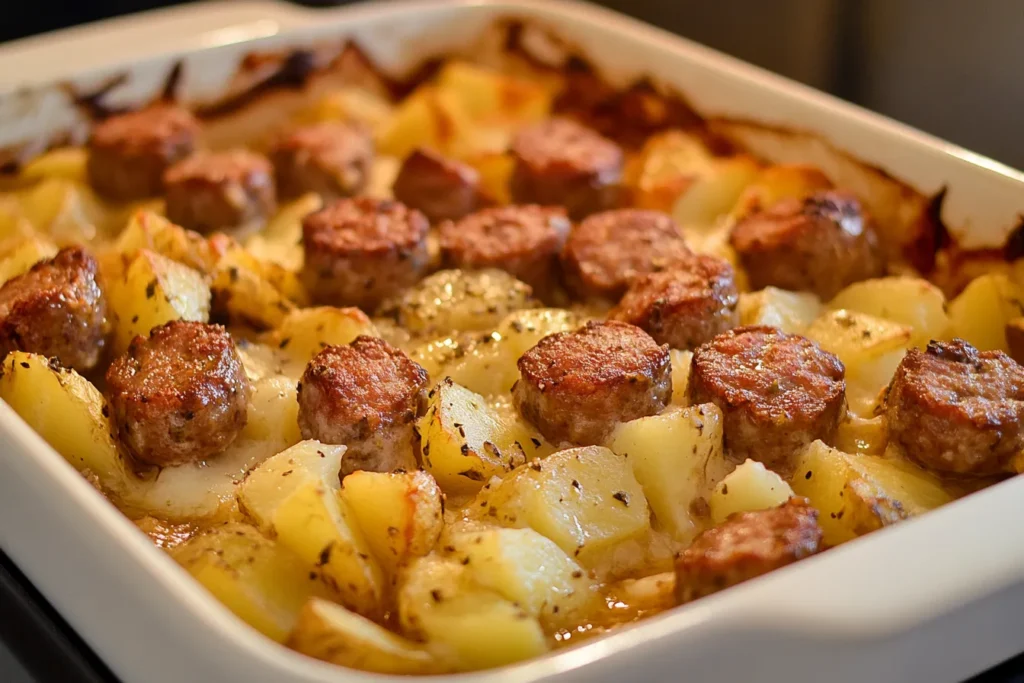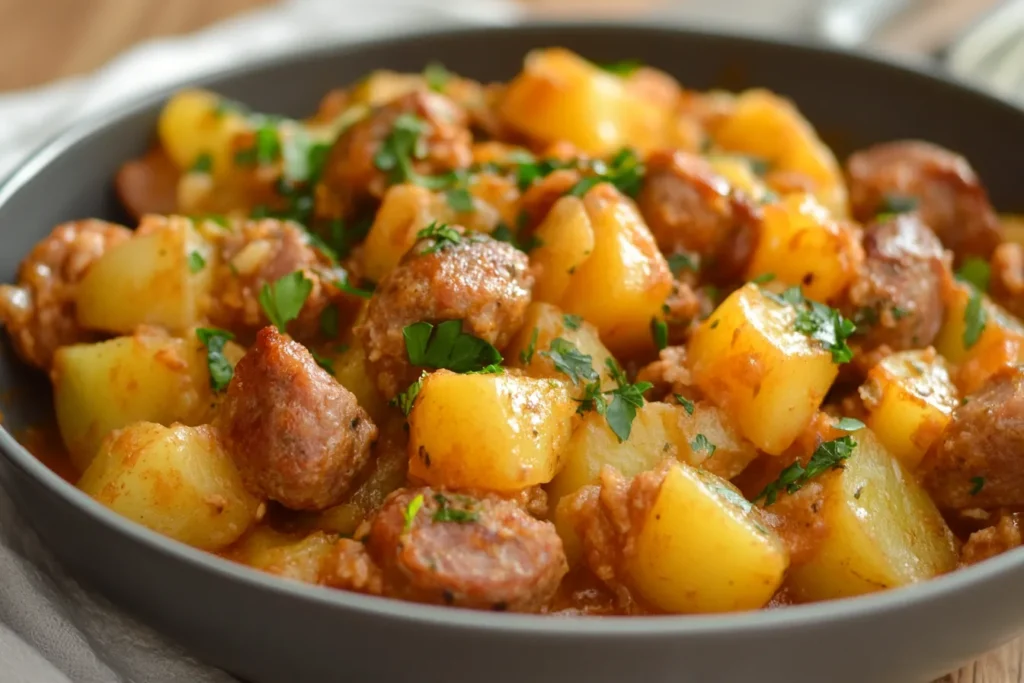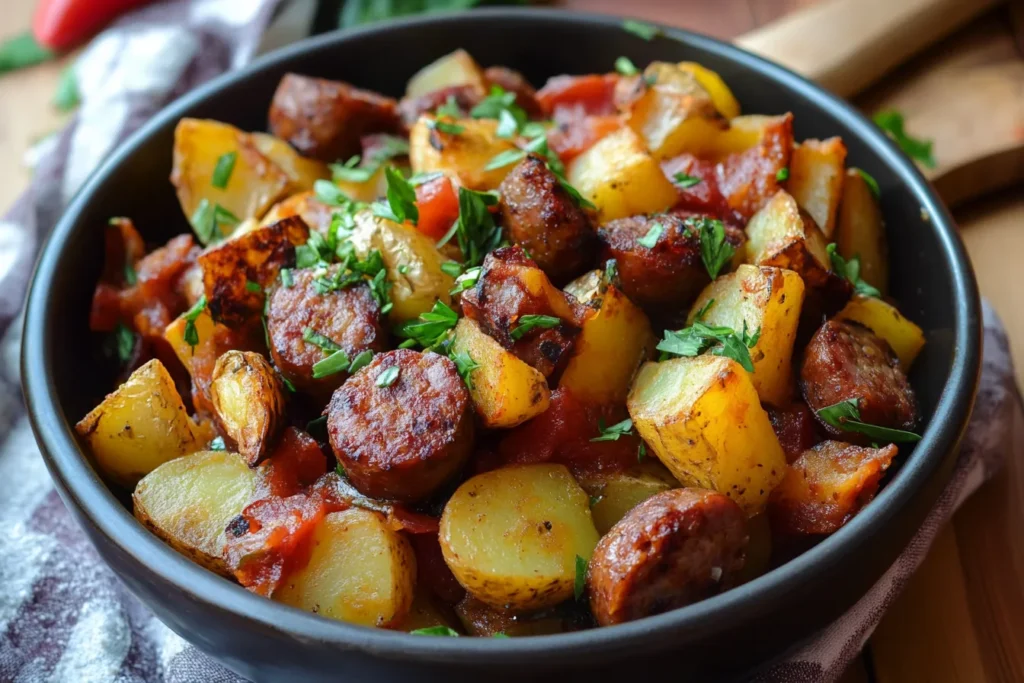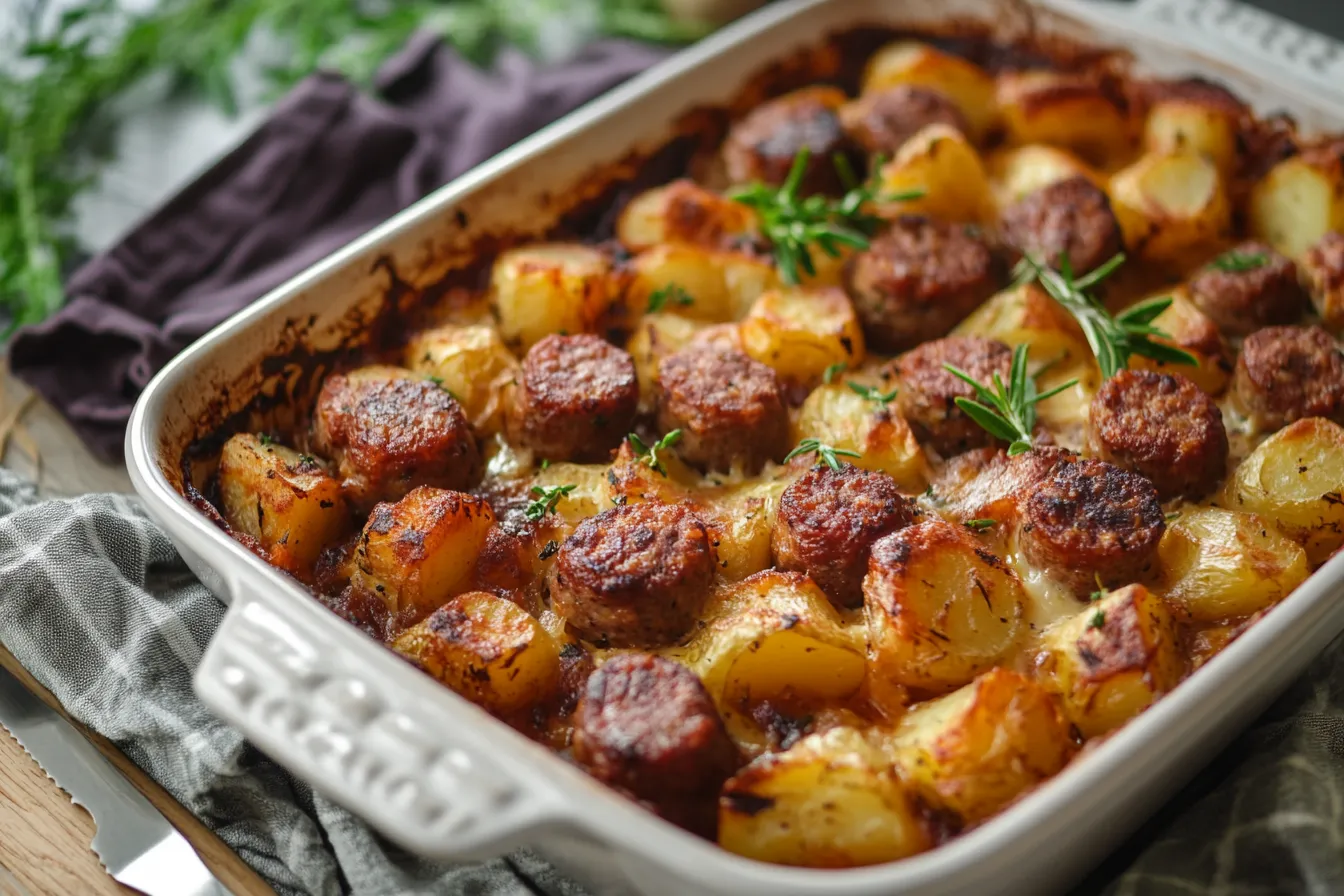Have you ever wondered why Italian sausage has such a unique, mouthwatering flavor that makes every dish it touches taste amazing? Whether it’s layered on a pizza, stirred into pasta, or grilled to perfection, there’s just something about Italian sausage that hits differently. The secret? It’s all about the bold, perfectly balanced seasoning. If you’ve ever struggled to add that extra oomph to your meals, Italian sausage is the answer—it’s a simple way to pack in rich, savory flavor without much effort. I know I’ve been there, staring at a plain dish, wondering how to elevate it, and then bam—Italian sausage saves the day. Its mix of herbs, spices, and juicy texture turns everyday recipes into unforgettable meals. Let’s dive into what makes it so good—and so irresistible!
List Of Contents
Introduction
Italian sausage has not only captured the hearts but also the taste buds of food lovers worldwide. Moreover, it is celebrated for its robust flavor, unparalleled versatility, and remarkable ability to elevate almost any dish. This iconic sausage, with its universal appeal, continues to charm culinary enthusiasts across cultures. However, what truly makes it so irresistible? From its rich historical roots to the meticulous art of seasoning, the journey of Italian sausage is as captivating as the flavors it delivers. Therefore, let’s delve deeper into its fascinating story and explore the unique attributes that make it a timeless favorite.
A Brief History of Italian Sausage
The origins of Italian sausage trace back to ancient times. Sausages were a staple in Roman cuisine, with early records mentioning lucanica, a precursor to modern Italian sausage. This was a flavorful blend of ground pork, spices, and herbs, first introduced to Roman soldiers during their campaigns in Lucania (modern-day Basilicata). The Romans perfected sausage-making as a way to preserve meat and infuse it with intense flavors.
Fast forward to today, Italian sausage is synonymous with traditional Italian cooking, symbolizing the regional diversity of Italy. Each region has added its own twist, influenced by local spices, preparation techniques, and cultural preferences. Check out more recipes here.
Regional Varieties of Italian Sausage

Italy’s diverse geography has given rise to a variety of regional Italian sausages, each with its own distinct flavor profile:
- Salsiccia Toscana: Found in Tuscany, this sausage is seasoned with fennel seeds and often paired with hearty soups or beans.
- Nduja: A spicy, spreadable sausage from Calabria made with pork fat, Calabrian chili peppers, and spices.
- Cotechino: A cooked sausage from Modena, traditionally eaten during the New Year alongside lentils.
- Soppressata: A cured sausage with variations ranging from sweet to spicy, depending on the region.
These variations not only reflect Italy’s culinary diversity but also showcase the deep connection between Italian sausage and local traditions. Check out more recipes here.
The Art of Seasoning Italian Sausage
Seasoning is where the magic happens. Italian sausage is a testament to the art of balancing flavors, where spices and herbs work in harmony to create a perfect bite.
Sweet vs. Spicy Italian Sausage
There are two primary categories of Italian sausage:
- Sweet Italian Sausage: Known for its mild flavor, this variety uses fennel and a hint of sugar to balance the natural sweetness of pork.
- Spicy Italian Sausage: The bold counterpart, seasoned with crushed red pepper flakes for a punch of heat.
The choice between sweet and spicy often comes down to personal preference and the dish being prepared. Check out more recipes here.
The Role of Fat in Italian Sausage
Fat content is crucial in Italian sausage, as it contributes to its texture, juiciness, and flavor. A good sausage typically contains about 20–30% fat, ensuring it remains moist and flavorful during cooking. The fat also acts as a carrier for the spices, helping to distribute them evenly throughout the meat. Check out more recipes here.
Authentic vs. Commercial Italian Sausage
The debate between handcrafted and mass-produced sausage is one of quality versus convenience. Authentic Italian sausage, often made by local butchers, emphasizes freshness and premium ingredients. Commercial versions, while widely available, may include fillers, preservatives, and lower-quality meat. Check out more recipes here.
Quality of Meat in Italian Sausage
Premium pork makes all the difference in the flavor of Italian sausage. Traditional recipes often use pasture-raised pork, known for its robust taste and superior texture.
The Smoking and Curing Process
Some varieties of Italian sausage undergo smoking or curing, adding depth to their flavor. For example:
- Cured sausages like soppressata develop complex flavours over time through fermentation.
- Smoked varieties offer a bold, smoky aroma that pairs well with rustic dishes.
These processes enhance the versatility of Italian sausage, making it suitable for both fresh and cured applications.
Culinary Uses of Italian Sausage
Italian sausage isn’t just a standalone star; it’s a versatile ingredient that enhances countless dishes. Its savory flavor and rich texture make it a favorite in kitchens worldwide. Whether incorporated into pasta dishes, served as a pizza topping, or grilled to perfection, its adaptability is unmatched.
Italian Sausage in Pasta Dishes
Italian sausage takes pasta to the next level, providing a hearty and flavorful protein source that pairs beautifully with tomato-based sauces, creamy alfredos, or even light olive oil-based dressings. Here are some classic dishes that showcase its brilliance:
- Lasagna: Layered with pasta sheets, ricotta, and marinara, Italian sausage adds depth and richness to this Italian classic.
- Spaghetti Bolognese: Replacing or complementing ground beef, sausage imparts a bold, savory flavor to the sauce.
- Baked Ziti: Crumbled sausage adds a spicy or sweet contrast to gooey mozzarella and tangy marinara sauce.
Its ability to complement and elevate these dishes is why Italian sausage is a staple in Italian-American cooking.
As a Pizza Topping
Few pizza toppings are as beloved as Italian sausage. Its bold flavors can stand up to a variety of ingredients, making it a perfect partner for:
- Traditional combinations like sausage and peppers or sausage and mushrooms.
- Gourmet creations featuring caramelized onions, arugula, or goat cheese.
- Spicy variations with jalapeños and spicy marinara.
The natural oils from the sausage infuse the crust and cheese during cooking, creating an irresistible slice every time.
Grilled and Standalone Dishes
Italian sausage shines on its own when grilled or cooked over an open flame. Its natural casing crisps up beautifully, providing a satisfying snap with every bite. Common standalone dishes include:
- Sausage and Peppers: A simple yet iconic dish where sausage is paired with sautéed bell peppers and onions.
- Barbecue Sausage: Grilled sausages served with mustard, pickles, and crusty bread.
- Sausage Sandwiches: Perfect for street fairs, these sandwiches are often loaded with toppings and served on a fresh bun.
When prepared this way, the sausage’s full flavor profile takes center stage.
Italian Sausage in Soups and Stews

In hearty soups and stews, Italian sausage serves as both a flavor base and a protein source. It enriches the broth with its spices and juices, creating dishes like:
- Zuppa Toscana: A creamy soup with sausage, potatoes, and kale.
- Sausage and Lentil Stew: Packed with earthy lentils and aromatic spices.
- Cassoulet: A slow-cooked French-inspired dish with sausage, beans, and duck or pork.
These dishes highlight how Italian sausage can transform simple ingredients into a gourmet experience.
Nutritional Aspects of Italian Sausage
While undeniably delicious, Italian sausage’s nutritional profile is worth considering. Understanding its protein, fat, and sodium content can help you enjoy it in moderation while maintaining a balanced diet.
Protein Content
It is a great source of protein, offering about 16–20 grams per serving. This makes it a valuable addition to meals for those looking to increase their protein intake, supporting muscle growth, repair, and overall health.
Sodium and Calorie Considerations
One drawback of it is its relatively high sodium and calorie content:
- Sodium: A single serving can contain up to 800 milligrams of sodium, nearly 35% of the recommended daily intake.
- Calories: Depending on fat content, sausages can range from 200–300 calories per link.
To mitigate this, consider pairing it with low-sodium ingredients or enjoying it in smaller portions.
Gluten-Free and Keto-Friendly Options
Many Italian sausages varieties are naturally gluten-free, making them suitable for those with gluten sensitivities or celiac disease. Additionally, sausage fits well into a keto diet due to its high fat and protein content and minimal carbohydrates. Look for artisanal or specialty sausages that align with specific dietary needs.s
Cultural Significance of Italian Sausage
It is more than just food; it’s a cultural symbol deeply woven into Italy’s culinary traditions and global gastronomy. Its versatility and robust flavor have made it a staple in kitchens worldwide, with chefs and home cooks alike embracing its ability to elevate any dish. Let’s explore its cultural roots, global reach, and influence on modern cuisine.
Italian Sausage in Traditional Festivals
In Italy, food is a celebration of life, and it plays a central role in many traditional festivals and family gatherings. Some examples include:
- Festa della Salsiccia (Sausage Festivals): Celebrated in regions like Calabria and Umbria, these festivals highlight local sausage-making traditions, offering visitors a taste of freshly prepared salsiccia.
- Feast of San Giuseppe (St. Joseph’s Day): it’s is often featured in dishes served during this feast, such as the delicacy and lentils or hearty casseroles.
- Christmas and New Year’s Eve: Sausage dishes like cotechino with lentils are considered good luck for the New Year, symbolizing prosperity and abundance.
These traditions underscore how it is more than a dish—it’s a shared experience that brings people together.
Globalization of Italian Sausage
The Italian treat has transcended borders, becoming a favorite ingredient in cuisines around the world. In the United States, Italian-American communities popularized its use in pizza, pasta, and barbecue, leading to its widespread availability in supermarkets and restaurants. In places like South America and Australia, local adaptations have emerged, blending it with regional spices and cooking techniques.
The global appeal of it lies in its adaptability. Whether it’s used in spicy Tex-Mex dishes or traditional French cassoulet, it effortlessly enhances flavors and complements diverse culinary styles.
Influence on Modern Cuisine
Chefs around the world are constantly innovating with it, incorporating it into contemporary dishes that push the boundaries of traditional cooking. Some examples include:
- Sausage-Stuffed Vegetables: Bell peppers, zucchini, and eggplant are filled with a blend of sausage, herbs, and breadcrumbs for a modern twist on stuffed vegetables.
- Sausage-Inspired Charcuterie: Artisanal sausages boards pair Italian sausage with gourmet cheeses, olives, and crusty bread.
- Fusion Cuisine: It is used in tacos, sushi rolls, and even Asian stir-fries, demonstrating its versatility in blending with non-Italian flavors.
This evolution reflects the sausage’s enduring appeal and its ability to inspire creativity in the kitchen.
Cooking Techniques for The Delicacy
Cooking the Italian sausages to perfection requires attention to detail. Its natural casing, seasoning, and fat content make it incredibly flavorful when prepared using the right techniques.

Searing, Grilling, and Baking
Each cooking method brings out unique qualities in it:
- Searing: Cooking sausage in a hot skillet develops a golden-brown crust, locking in juices and intensifying flavors.
- Grilling: Ideal for summer barbecues, grilling enhances the smoky, charred notes of the sausage.
- Baking: Baking in the oven is a healthier option that ensures even cooking without the need for additional fats.
To achieve the best results, it’s essential to cook sausages over medium heat to avoid burning the exterior before the interior is fully cooked.
Pairing Italian Sausage with Wines and Sides
It pairs beautifully with a range of wines and sides. Some complementary pairings include:
- Wines: A robust red wine like Chianti or Barbera balances the sausage’s richness, while a crisp white wine like Pinot Grigio pairs well with milder varieties.
- Sides: Popular side dishes include roasted vegetables, creamy polenta, or garlic-infused mashed potatoes.
These pairings transform a simple meal into a gourmet experience.
Making Italian Sausage at Home
Crafting It at home allows you to tailor the flavors to your liking and ensure the use of high-quality ingredients. The process may seem daunting, but with the right tools and techniques, it’s an achievable and rewarding experience.
Selecting Ingredients
The foundation of a great sausage lies in the ingredients:
- Meat: Choose fresh, high-quality pork, preferably from the shoulder or belly for the perfect balance of meat and fat.
- Seasonings: Fresh garlic, fennel seeds, salt, and optional red pepper flakes are must-haves. Experiment with additional herbs like basil or parsley for a unique touch.
Mixing and Stuffing Techniques
Once you’ve gathered your ingredients:
- Grind the Meat: Use a meat grinder to achieve the desired texture.
- Season Generously: Mix the ground meat with your selected spices and herbs, ensuring even distribution.
- Stuff the Casings: Using a sausage stuffer, fill natural casings (usually made from pork intestines) with the meat mixture.
Patience and precision are key to creating evenly stuffed sausages with no air pockets.
Storing and Preserving Homemade Sausage
To ensure freshness:
- Store raw sausages in the refrigerator for up to 3 days.
- For longer preservation, freeze them in airtight containers for up to 3 months.
- If making cured sausages, follow proper curing guidelines to prevent spoilage.
The homemade method not only tastes better but also connects you to the rich tradition of sausage-making.
Conclusion: The Timeless Appeal of Italian Sausage
It remains a culinary treasure, celebrated for its rich history, bold flavors, and cultural significance. From its humble beginnings in ancient Rome to its place in modern kitchens worldwide, it continues to captivate food enthusiasts with its versatility and irresistible taste. Whether grilled to perfection, tossed into pasta, or crafted at home, It is a testament to the enduring power of simple, well-balanced ingredients.
FAQS
- What makes Italian sausage different from regular sausage?
It is distinguished by its use of fennel seeds and specific spices like garlic and red pepper flakes. - Can I use Italian sausage in non-Italian recipes?
Absolutely! Its robust flavor makes it a great addition to dishes like casseroles, tacos, and soups. - What’s the best way to cook Italian sausage?
Searing and grilling are popular methods that enhance its flavor, but baking is also an excellent option for even cooking. - Is Italian sausage gluten-free?
Most Italian sausages are naturally gluten-free, but always check labels for additives or fillers. - What’s the difference between sweet and spicy Italian sausage?
Sweet sausage focuses on fennel and mild seasonings, while spicy sausage includes red pepper flakes for added heat. - Can I make Italian sausage without a casing?
Yes, you can shape the mixture into patties or crumble it for cooking without using casings. - How long does Italian sausage last in the fridge?
Fresh sausage should be consumed within 3 days, while frozen sausage lasts up to 3 months. - What wine pairs best with Italian sausage?
Red wines like Chianti or white wines like Pinot Grigio complement it flavors beautifully. - Is Italian sausage keto-friendly?
Yes, its high fat and protein content make it suitable for a keto diet, provided it’s free of added sugars. - Can I substitute it in recipes that call for other sausages?
Yes, but keep in mind that its strong flavors may alter the dish’s intended taste.
